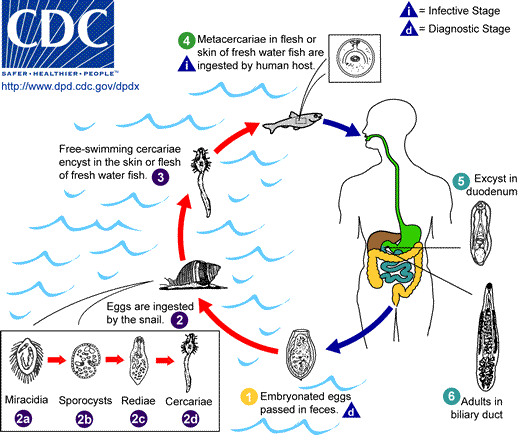Trematodes
Trematodes are a class of flatworms. There are bilaterally symmetrical first-mouth animals that live exclusively parasitically, most of which are vertebrate endoparasites. The class Trematoda contains the subclass Digenea, which includes four orders: Strigeatoidea (representative: Schistosoma haematobium), Echinostomida (representative: liver fluke), Opistrochiida (representative: Egyptian fluke) and Plagiorchiida (representative: pulmonary fluke).
Macroscopic description[edit | edit source]
The size of the motolic body can be from tenths of a millimeter to several centimeters. The body is flattened, usually has at least one suction cup, it can have more than one. The suction cup is used to attach the trematode to the host. There may be hooks or protrusions on the body. The body may be covered with glycocalyx, which has a protective function.
Pathogenesis[edit | edit source]
They are mainly parasites of the digestive and respiratory systems, but can be parasites in almost all organ systems. Some species cause disease in their hosts. Diseases caused by trematodes are called trematodoses. They damage the hosts both mechanically and the products of their metabolism, if they occur in the digestive tract, deprive the host of part of the ingested food. In addition to the gonochoristic family Schistosomatidae and some members of the family Didymozoidae, these are hermaphrodites.
Life cycle[edit | edit source]
Trematodes go through several development cycles. The first larval stage is called miracidium and develops into a fertilized egg, which then leaves. The first intermediate host is usually a snail. Parthenogenesis occurs in the body of this intermediate host (a new individual develops from an unfertilized egg). The first generations are sporocysts, followed by redia and cercariae. The cercaria leaves the intermediate hosts and floats in the water. There are several ways to get to the final host and turn into a worm.
Links[edit | edit source]
External links[edit | edit source]
Literature[edit | edit source]
- VOTAVA, Miroslav. Lékařská mikrobiologie speciální. 1. edition. Brno : Neptun, 2003. 495 pp. ISBN 80-902896-6-5.
- VOLF, Petr – HORÁK, Petr. Paraziti a jejich biologie. 1. edition. Praha : Triton, 2007. 318 pp. ISBN 978-80-7387-008-9.

